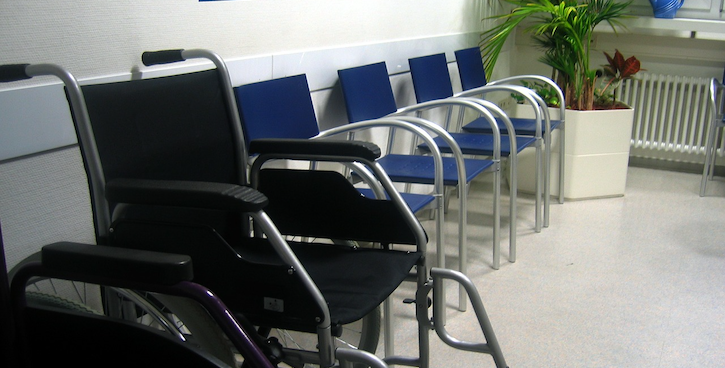5 Benefits of Digitizing Your Intake Process
Moving the patient experience from average to superior.

Long wait times and boring paperwork. Two things that are nearly universally disliked. And yet, the vast majority of hospitals and large health systems are asking patients to spend lots of time on just that. For many patients, hours (or at least what feels like hours!) may be spent sitting around in waiting rooms—often juggling mounds of forms and clipboards while they do so. Unfortunately, these patients inevitably end up feeling stressed and disgruntled. Definitely not the experience they expect. And it is the hospital that ends up suffering the most—studies show that hospitals in the U.S. that provide a “superior” patient experience see net margins that are 50% higher than those that deliver an “average” customer experience.
So what can move the patient experience from average to superior? Unsurprisingly, a recent survey found that the answer is usually closely tied to technology. In fact, according to the survey, patients are increasingly wanting to connect with their healthcare organizations via technology. Some of these advances have already gained widespread recognition and are increasingly seeing implementation. For instance,
- 85% of patients want virtual care access
- 97% want online scheduling
- 92% want online payment tools
One of the more recent digital shifts is related to the intake process. Virtually all patients—93% to be exact—say that they expect healthcare organizations to use digital tools when interacting with them, and this includes during the intake process.
It makes sense. If we’re talking about one of the most mundane and cumbersome parts of a doctor visit, paperwork and registration definitely come to mind. In fact, the average doctor’s visit involves 64 minutes of waiting for care and filling out paperwork. For large health systems or hospitals, these numbers are often even higher. In a society where we’re accustomed to streamlining processes through our computer or smart phone when interacting with pretty much any other business, it is easy to see why patients get frustrated when dealing with their healthcare organizations.
Fortunately, using an online intake process comes with a bevy of benefits for both healthcare organizations and patients, making implementation a lot easier to manage. These benefits include things such as:
- Reducing unnecessary expenses. Did you know that 3% of your annual revenue is spent on paper? That doesn’t even include printing costs or postage if you mail forms ahead of time! These small costs really do add up. Using digital forms rather than paper not only saves trees—it saves wasted money for healthcare organizations.
- Improving accuracy. Transferring all of the data written on a paper form into the computer inevitably leads to typos when copying things like social security numbers, addresses, and so on. In fact, experts estimate that 61% of claim denials are due to simple demographic or technical errors. These manual errors end up costing healthcare organizations more time and money.
- Protecting patient privacy. Successfully managing private patient information is a critical piece of healthcare management. Compliance, reputation, and overall success are at stake. Unfortunately, a large-scale survey recently found that medical-related identity theft accounts for 43% of all identity theft reported in the U.S.―this is more than what is experienced in banking, finance, government, military, or the education sectors. Much of this fraud can be attributed to sloppy handling of paper medical files or outright theft of personal data. An online check-in process is a more secure way to manage private patient information.
- Saving time. The check-in process is one of the major bottlenecks within any healthcare organization. Even one or two mishaps can throw off your schedule for the rest of the day. Automating the intake process helps expand that bottleneck to allow for a better patient flow. This is especially true for large organizations where many patients are seen each day.
- Improving the patient experience. It is easy to get so busy running our healthcare organizations that many times we don't even notice how unpleasant it is to fill out paper forms for patients. Not only does it take up time in the waiting room (when they may already be feeling a bit anxious), but it also makes the experience that much more difficult for patients. Allowing patients to take care of this task before even leaving home is an incredible benefit for patients.
Digital intake forms are the future of the check-in process. It helps healthcare organizations save time and money all while improving both security and the patient experience. What are you waiting for?
Jim Higgins is the founder & CEO of Solutionreach. You can follow him on Twitter: @higgs77
Get the best insights in digital health directly to your inbox.
Related
Patient Engagement Is a Priority for Healthcare Execs in 2019
Podcast: Match Made in Hospitals — Patient-Matching Technology Can Improve Healthcare
September 21st 2021Clay Ritchey, CEO of Verato, highlights the administrative and financial benefits that patient-matching technology can provide hospitals and health systems, as well as how it can improve the patient experience.
Podcast: Using Digital Solutions to Address Technology Shortfalls with Citius Tech Senior VPs
July 29th 2021In an interview recorded earlier this year, Chief Healthcare Executive Associate Editorial Director Mary Caffrey spoke with 2 leaders of Citius Tech about meeting healthcare challenges with digital solutions.